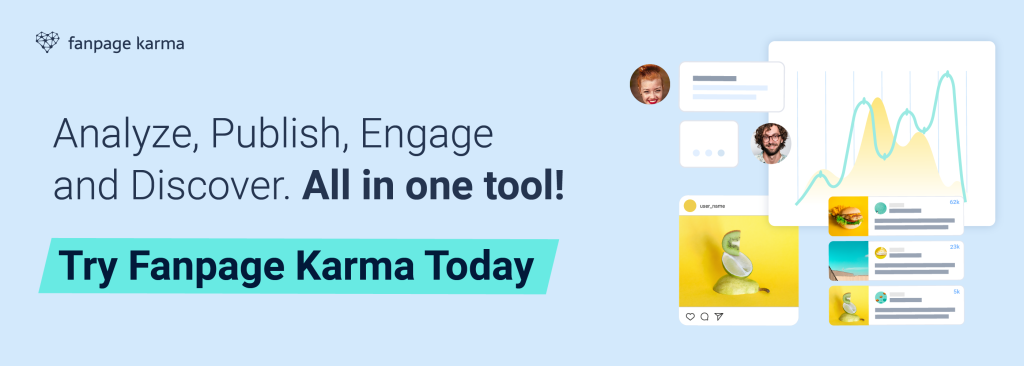The One Prompt for All Your Social Media Copy

In our series on the best prompts for content creators, we’ll look at the best prompt ideas and advanced workflows that can help us harness the potential of AI tools and scale our content.
In today’s third part of the series, we’ll let AI help us create captions, tweets, Threads posts, and video descriptions – in short, copy for our social media posts.
These AI tools help with copywriting for social media posts
There are a handful of tools that are helpful for creating copy for our social media posts. These include:
- Fanpage Karma’s K’s AI caption generator
- Copy AI
- Jasper
- Peppertype AI
- Writesonic
- ChatGPT
Some tools, such as Fanpage Karma’s AI caption generator, are made for the sole purpose of creating social media captions and work just fine without having any understanding of prompting. Other tools like ChatGPT, which are made for a wider usage, first need to be instructed by a precise prompt that explains what kind of text you wish to create.
Once we have found an AI assistant, we should then collect all the important information that we want our AI assistant to take into account when creating our copy.

Collect all the information
Here’s what we need to know about our post before we compose our prompt:
- The post format and the platform on which the post will be published: TikTok video, LinkedIn carousel post, etc.
- The topic and key messages of our content.
- The goal of our post (inspirational, entertaining, funny, or thought-provoking).
- Whether our post is intended to provoke an action from the user (e.g., clicking on a link where they can find more information).
- The target audience for whom the post is being created and the style of language to be used.
- The length of the text.
If you want to find out more about which topics, post formats, and social media platforms are best for your content strategy and for reaching your target audience, read this article. Learn more about AI-driven content creation for social media video here.
Before we start drafting our final prompt for our text copy, we need to decide whether we want to use one of the following three elements:
- a hook and/or call-to-action
- SEO keywords
- hashtags.
Prepare the important building blocks
Depending on whether we want to use a hook, a call-to-action, hashtags or SEO-related terms in our text copy, we will create these parts separately now. In this way, we get several suggestions for each of these building blocks. We then integrate our favorite into the final prompt to create the final copy for our social media post.

Find relevant SEO keywords
“I will provide you with the summary of a [platform + format, e.g. TikTok video, LinkedIn carousel post, etc.].
Act as an SEO expert conducting keyword research.
[Platform + post format, e.g. The TikTok video] was created for the following target audience: [information about our target audience].
Give me an appropriate seed keyword as well as a list of [15] SEO keywords that should be used for the [text type + platform + format, e.g. description of this YouTube Short video, caption of this LinkedIn Carousel post, etc.]. Make sure the keywords all have a higher search volume than [X] on [platform, e.g. YouTube].
The goal is for [format, e.g., the video] to rank high in the search results our target audience receives when searching for [our topic or questions addressed in our content] on [platform, e.g., YouTube].
[Optional: Summary of the [post format, e.g., video]: [main content points of the post].”
Find relevant hashtags
“Also, give me a list of [25] hashtags that should be used for the [platform + format, e.g. YouTube video description]. Make sure the hashtags match the topic and content of the [platform + format, e.g., YouTube video].”
Find relevant CTAs
“Create [X] calls-to-action for [platform + format, e.g., a YouTube video description] for this post.”
If we already know what we want the CTA to look like, we add that to the prompt above.
Find a hook that fits
“Create a hook for [platform + post format, e.g. a YouTube video description] for this post.
The goal of the hook is to [our goal, e.g., provide an element of surprise].”
If we already have ideas about what the hook should look like, we can add it to the prompt above:
“It should contain [hook type, e.g., an exciting question to the audience / etc.].”
We then select our favorite keywords, hashtags, CTA, and hook for our post.

Three ingredients that make great AI copy
Now we have all the information we want to share with our AI assistant about our post. We can now turn our attention to creating our final social media copy. The prompt to create this final copy consists of three parts:
- Assigning a role to the AI assistant
- Inserting the relevant background information about the social media post
- Inserting the relevant information about the copy to be created.
The first two parts are the same whether you are creating captions, video descriptions, tweets, Threads posts, or a video title. The third part differs depending on the type of text copy we choose to create.
Assign a role to the AI
We start by assigning a new role to our AI assistant:
“Act as a social media marketing expert.”
Enter relevant background information about the post
Now we can start writing our final request. During this process, it is important to share all the information we have collected. We start with information about the post:
“Below I will give you some information about the post:
Platform on which the post is published: [platform, e.g. TikTok].
Goal of the post: [purpose or intention of the social media post, e.g., to associate our brand with joie de vivre and humor].
Target audience for whom the post is created: [information about our target audience].
The topic of the post is the following: [topic].
The post is about the following: [summary with the main points of the post].”
Finalize the prompt by specifying the post type
The last thing we need to do is specify the requirements that are specific to the text we want the AI to generate.
Captions and video descriptions, tweets, Threads, and full-text posts
Now we add the following to the prompt above:
“Create [X, e.g. 3] [text type, e.g. captions, video descriptions, tweets, or Threads posts] for this social media post. The [text type] should take into account the following:
[Personal wishes, e.g.: Clarify the key benefits and value the video provides to the viewer. Highlight why a typical member of our target audience should watch the [entire] video].
Language style to be used: [style of language, e.g., “in the style of [well-known author]” or “humorous”]
Length of [text type, e.g., the tweet]: [desired number of words or characters, e.g., 140 characters].
[Optional:
Hook to be used: [Hook we decided to use]
Call-to-action that should be inserted at the end of the [text type, e.g. caption]: [CTA we decided to go for].
Hashtags to be used: [hashtags we have decided to use].
Optimize the [text type, e.g. YouTube video description] for search engines by including the following keywords and related phrases in the [text type], especially in the first 1 to 2 sentences: [list of keywords we decided to use].”
The exact wording will differ slightly depending on whether we want to create captions, video descriptions, tweets, Threads posts, carousels, or full-text posts.
The created caption or video description, Tweet or Threads post should now perfectly match our post topic and be optimized for high visibility on social media.

Video titles and headlines
Social media videos, like the one we created in the last blog post, will still need a title. Again, the AI assistant can help us with this:
“This social media post is a [platform + content type, e.g. YouTube short]. Develop [5] engaging titles for this post.
The title should [goal of the title, e.g., pull viewers out of their scrolling routine and make them feel like they’re missing out if they don’t watch the video].
Incorporate the following keyword into the title to optimize the title for search engines: [our seed keyword].”
Alternatively, we can provide our AI assistant with a title format that already works well for us and have it give the AI suggest titles of a similar style:
“Here’s a title for one of my [platform + format, e.g. YouTube shorts]: [we’ll insert the title]. I like this title because it’s [we’ll insert why we like the title].
Create [5] title ideas for the social media post that have a similar impact as the title of the [platform + format, e.g., YouTube Short] described above.”
Conclusion
Depending on the goal of our post and the post format, AI assistants can give us creative ideas for our social media copy. These ideas can help us post more relevant content in less time. This is especially true if a task is not easy, or if we don’t like to do it (e.g. the integration of target group relevant SEO keywords). In these cases, our AI assistant can give us a helping hand.






